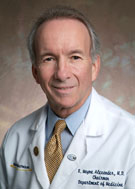On June 15, 2010, vascular biologist Kathy Griendling delivered the 2010 Dean’s Distinguished Faculty lecture at Emory University School of Medicine.
Some of Griendling’s publications have been cited thousands of times by fellow scientists around the world, making her the lead member of a small group of researchers at Emory called the “Millipub Club.”
With her five children and one grandson watching in the back row, Griendling explained how she and her colleagues, over the course of more than two decades at Emory, have gradually revealed the functions of a family of enzymes called NADPH oxidases in vascular smooth muscle cells.
NADPH oxidases generate reactive oxygen species such as superoxide and peroxide. Before her team’s discoveries, these molecules were thought to be toxic. Their only known function was in neutrophils, a type of white blood cell, which release them to fight bacteria.

Wayne Alexander, MD
Griendling described evidence showing that reactive oxygen species and NADPH oxidases are central to transmitting signals for the regulation of blood vessel function in vascular smooth muscle cells. Along the way, she had some advice for young scientists walking in her footsteps:
*Listen to your mentor.
Griendling said that she started off studying norepinephrine (a neurotransmitter that is certainly not unimportant) but switched to studying angiotensin, a hormone that regulates blood pressure, after being urged by Wayne Alexander, MD, who is now Chair of the Emory Department of Medicine but then was at Harvard Medical School.
*When stumped, seek advice from colleagues, especially those named Dave.

Cardiologist David Harrison, MD |
|
Collaborations with Harrison and Lambeth helped Griendling uncover the role NADPH oxidase plays in hypertension and also led her to the discovery of additional forms of the “Nox” enzymes, which have a variety of functions in vascular smooth muscle cells’ growth and migration. |
*Recruit talented postdocs and graduate students.
Griendling came back to this theme more than once, and she’s had many lab members over the years, as illustrated by her lab’s Web page.
She ended with some thoughts on the difficulties in translating insights on reactive oxygen species’ importance to the clinic (a theme Emory Medicine magazine has examined as well). She said that clinical studies looking for the beneficial effects of antioxidants may have been looking at the wrong endpoints or the wrong targets.



